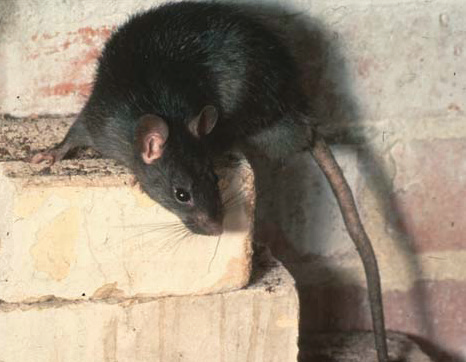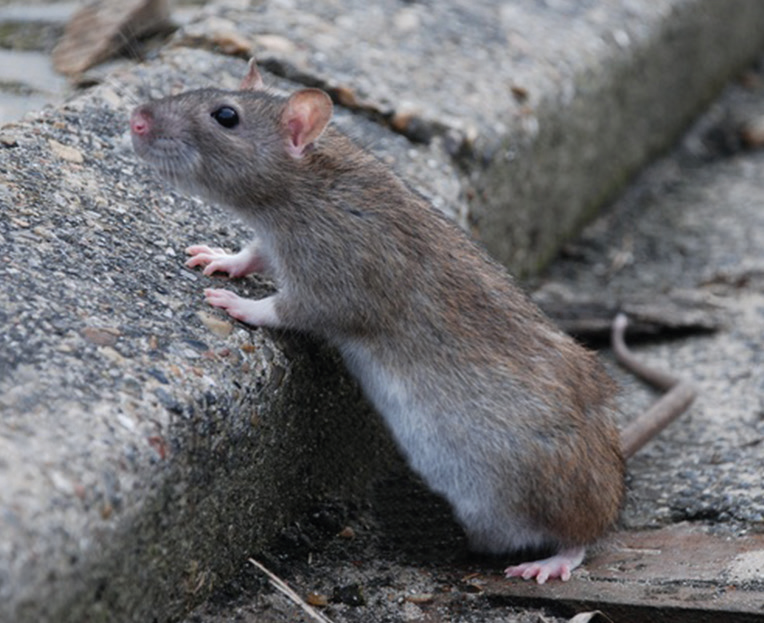EXCLUSION OF THE BLACK RAT
What can you do to make sure that the black rat doesn't settle in buildings, under roof tiles or in sheds,
and cannot get at any food sources?
- Don't put out or hang food in your garden (no bread, food left-overs or fatty balls for the birds).
- Remove any fallen fruit or nuts.
- Don't leave waste orÍood left-overs in plastic bags in your garden. Keep waste in containers or waste bins that
can be closed properly. - If you have pets in your garden, make sure rats cannot get at the food in the hutch and the run. One way to do
this is to cover the outside and floor of the hutch with chicken wire with a mesh size of no more than 0.5 cm.
This also keeps the house mouse out. If you have a run, it's best to let the chicken wire extend to below the run,
at a depth of 50 cm. - Do everything possible to seal any gaps or cracks larger than 0.5 cm in your house, shed or garage, which will
prevent rats and mice getting indoors to nest. Use hard materials for this, that cannot be chewed through,
such as èement, metal grids or chicken wire. Important: ventilation openings must continue to ventilate. - Clean and tidy your shed or garage regularly so that rats cannot nest there.
- Avoid long-term storage of materials in the garden, such as pruned branches, construction materials and
Íirewood.
These measures will only be effective iÍ you and your neighbours all apply them. We have had good results with this
approach In Eindhoven already. In response to sightings oÍ the black rat, residents posted information on the neighbourhood website and made flyers asking people to clear up waste and seal openings. They also visited neighbours who had waste or food scraps lying in their gardens to ask them to remove it and informed the housing associations of the situation. These measures got good results.
Additional information
Types oÍ rats
Two types of rats are found in Eindhoven: the black rat and the brown rat. The way of life and the physical appearance of the rat, and its droppings are different. The black rat comes in both black and brown. Distinguishing between types of rats can be difficult, so some expertise is necessary.
Black rat (left/first picture)
The black rat can be found almost exclusively in and around buildings such as homes, sheds and vacant buildings. It finds food inside or outside rabbit hutches, chicken and pigeon coops, bird-feeding places etc. and also around fruit and nut trees and berry bushes. The black rat's tail is longer (20-25 cm) than its body (15-23 cm). The droppings are dark and crescent-shaped, 1 cm long and 2-3 mm thick and are often spread out.
Brown rat (right/second picture)
The brown rat is generally found in the sewage system, near water, allotments and children's farms. It lives and feeds mainly outside buildings. The thick, almost hairless tail (approx. 20 cm long) is shorter than the body (approx. 25-30 cm). The droppings are dark and peanut-shaped and larger than those of the black rat; up to 2 cm long and 5-7 mm thick. The droppings often lie close together.


Health
Rats can transmit infectious diseases if they are carrying pathogens. Diseases can be transmitted by rat bites, droppings, breathing in the fumes of dried-up urine or contact with water polluted by urine. This does not occur frequently, and the risk is significantly smaller if you take precautions. Damp down droppings before you sweep them up and wear gloves if you are going to come in contact with rats or their droppings. Throw gloves away after use and wash your hands. If you are bitten by a rat, see your family doctor. Doctors report a number of diseases which can be transmitted by rats to the GGD (municipal health authority). Where necessary, the health authority informs the municipality, and measures are taken.
Responsibility
The brown rat lives around or near city waterways and the municipality commissions its monitoring. If rat populations get too large, Eindhoven Municipality takes control measures. The black rat lives mainly in buildings. The building owner or user (municipality, homeowner or tenant) is responsible for organising and paying for combating the black rat.
Control
Rats and other 'pests' normally have their place in nature. When there is too much food and enough places to nest, they can become a plague. Reducing the food supply and the number of places to nest will consequently reduce the numbers of rats. Control is only effective if preventive measures are also taken. If you wish to control numbers of rats, make sure that the food supply and the number of places to nest are tackled.
The black rat can be caught with a rat clamp
When catching rats with a rat trap, make sure you wear gloves when you take the rat out of the trap, to prevent it transmitting to you any diseases it may be carrying. Afterwards, throw away the gloves used. In the Netherlands individuals may not use poison (rodenticides) to control rat numbers. Only professional rodent control companies may use poison to combat rats and then only under very strict conditions. Which company you engage is your own decision. The advantage of using a professional rodent control company is that they work with trained staff who have knowledge of the animal and access to various methods of control. For a list of specialised companies, we refer you to the website of the dutch Association of rodent control companies: Plaagdiermanagement Bedrijven nvpb.org and the Platform Plaagdierbeheersing platformplaagdierbeheersing.nl .
Whichever action you take, do take it together with your neighbours. Only concerted action will help to keep rat numbers and the nuisance to a minimum.
What does the municipality do?
Always report any sightings of rats on your own, or public, ground to the municipality. Following your report about black rats, the municipality will arrange for an advisor from the KAD (centre for knowledge and control of animal infestations) to visit you, at no charge. The advisor will give recommendations about control and prevention and inform your direct environment, so that you and your neighbours can take appropriate measures.
 Eindhoven Municipality takes appropriate measures in its own buildings where black rats have been sighted. The municipality keeps problems with the black rat to a minimum by collecting waste as quickly as possible. The municipality also monitors the brown rat populatlon in the public space and combats it where necessary.
Eindhoven Municipality takes appropriate measures in its own buildings where black rats have been sighted. The municipality keeps problems with the black rat to a minimum by collecting waste as quickly as possible. The municipality also monitors the brown rat populatlon in the public space and combats it where necessary.
Your reports of sightings also help us to keep an eye on rat nuisance and take any extra measures needed. The municipality is informing residents and housing associations about the control and prevention of the black rat by way of this flyer, the website and home visits.
More info and reporting about rats: Eindhoven Municipality, eindhoven.nl , Phonenumber 14040